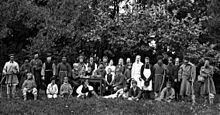The Chernigov Governorate (Russian: Черниговская губерния; translit.: Chernigovskaya guberniya), also known as the Government of Chernigov, was a guberniya in the historical Left-bank Ukraine region of the Russian Empire, which was officially created in 1802 from the Malorossiya Governorate with an administrative centre of Chernihiv. The Little Russian Governorate was transformed into the General Government of Little Russia and consisted of Chernigov Governorate, Poltava Governorate, and later Kharkov Governorate.
Chernigov Governorate borders are roughly consistent with the modern Chernihiv Oblast, but also included a large section of Sumy Oblast and smaller sections of the Kiev Oblast of Ukraine, in addition to most of the Bryansk Oblast, Russia.
The governorate consisted of 15 uyezds:
Borzna County
Glukhiv County
Gorodnya County
Kozelets County
Konotop County
Krolevets County
Nizhyn County
Novhorod-Siversky County
Oster County
Sosnytsia County
Chernihiv County
Mhlyn County
Novozybkov County
Starodub County
Surazh County
The Chernigov Governorate covered a total area of 52,396 km², and had a population of 2,298,000, according to the 1897 Russian Empire census. In 1914, the population was 2,340,000. In 1918 it became part of Ukraine and transformed into Chernihiv Governorate.
Russian Census of 1897
Nizhyn – 32,113 (Ukrainian – 21,733, Jewish – 7,578, Russian – 2,366)
Chernihiv – 27,716 (Ukrainian – 10,085, Jewish – 8,780, Russian – 7,985)
Konotop – 18,770 (Ukrainian – 10,290, Jewish – 4,415, Russian – 3,565)
Novozybkov – 15,362 (Russian – 11,055, Jewish – 3,787, Belorussian – 303)
Hlukhiv – 14,828 (Ukrainian – 8,621, Jewish – 3,837, Russian – 2,217)
Borzna – 12,526 (Ukrainian – 10,846, Jewish – 1,515, Russian – 109)
Starodub – 12,381 (Russian – 7,255, Jewish – 4,897, Ukrainian – 133)
Krolevets – 10,384 (Ukrainian – 8,328, Jewish – 1,815, Russian – 209)
Berezna – 9,922 (Ukrainian – 8,349, Jewish – 1,354, Russian – 144)
Novgorod-Seversky – 9,182 (Ukrainian – 4,884, Jewish – 2,941, Russian – 1,296)
Mhlyn – 7,640 (Russian – 4,840, Jewish – 2,675, Belorussian – 75)
Sosnytsia – 7,087 (Ukrainian – 5,068, Jewish – 1,840, Russian – 158)
Korop – 6,262 (Ukrainian – 5,309, Jewish – 865, Russian – 77)
Oster – 5,370 (Ukrainian – 3,229, Jewish – 1,596, Russian – 399)
Kozelets – 5,141 (Ukrainian – 2,834, Jewish – 1,632, Russian – 468)
Pogar – 4,965 (Russian – 3,800, Jewish – 1,159, Germans – 6)
Gorodnya – 4,310 (Ukrainian – 2,349, Jewish – 1,248, Russian – 604)
Surazh – 4,006 (Jewish – 2,400, Belorussian – 978, Russian – 559)
Novoye Mesto – 1,488 (Russian – 1,421, Jewish – 67)
By the Imperial census of 1897. In bold are languages spoken by more people than the state language.

